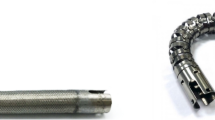Abstract
A testing device is developed that determines the stiffness, or flexural rigidity, of an endoscope at specific locations down its length by subjecting it to a compressive axial force, a situation similar to the actual forces applied to the endoscope during a clinical procedure. The endoscope is made to deform in a similar fashion to a slender buckled column and the force causing this deformation is related to the flexural rigidity using column buckling theory. A direct relationship between the critical load needed to cause buckling and the square of column length L is demonstrated experimentally and is expected theoretically, giving confidence in the application of column buckling theory to endoscope testing. Additional confidence in the validity of the columnbuckling test results is obtained by their similarity to data obtained by subjecting the endoscope to a transverse load, determining deflection, and modelling the endoscope as a bent elastic beam. Several makes and models of endoscopes were tested, with flexural rigidity values typically ranging between 160 to 240 Ncm2. The effect of a metal stiffener inserted in an endoscope's accessory channel is quantified, as is the change in flexural rigidity down the insertion shaft of a graded-stiffness endoscope. Significant differences in flexural rigidity were obtained between identical endoscopes, each sharing similar usage histories, indicating the need for flexural rigidity measurements for each individual endoscope of a particular model line, though a more extensive study is required to reliably determine scope-to-scope stiffness variations for a particular model line.
Similar content being viewed by others
References
Barthel, J., Hinojosa, T., Shah, H. (1995): ‘Colonoscope length and procedure efficiency’,J. Clin. Gastroenterology,21, pp. 30–32
Hughes, C. E., Gebhard, R. L., Peterson, L. R., Gerding, D. N. (1986): ‘Efficacy of routine fiberoptic endoscope cleaning and disinfection for killing clostridium’,Gastrointestinal Endoscopy,32, pp. 7–9
Knyrim, K., Seidlitz, H. K., Hagenmüller, F. andClassen, M. (1987): ‘Color performance of video endoscopes: quantitative measurement of color reproduction’,Endoscopy,19, pp. 233–6
Marshall, J. B. (1996): ‘Use of a pediatric colonoscope improves the success of total colonoscopy in selected adult patients’,Gastrointestinal Endoscopy,44, pp. 675–678
Nemirovskii, M. E. andKuz'min, A. I. (1985): ‘Investigation of the flexural and torsional rigidity of flexible elements of endoscopes’,Biomed. Eng.,18, pp. 213–217 Also in (1984)Meditsinkaia Tekhnika,6, pp. 31–34.
Popov, E. P. (1976): ‘Mechanics of materials’, 2nd edn. (Prentice-Hall, Englewood Cliffs, New Jersey), pp. 463–465
Reynolds, C. D., Rhinehart, E., Dreyer, P. andGoldmann, D. A. (1992): ‘Variability in reprocessing policies and procedures for flexible fiberoptic endoscopes in Massachusetts hospitals’,Am. J. Infection Contr.,20, pp. 283–290
Sakai, Y. (1987): ‘Techniques of colonoscopy’inSivak, M., Jr. (Ed.): ‘Gastroenterologic endoscopy’ (W. B. Saunders, Philadelphia), pp. 840–867.
Seidlitz, H. K. andClassen, M. (1992): ‘Optical resolution and color performance of electronic endoscopes’,Endoscopy,24, pp. 225–228
Tada, M., Iso, A., Ohtsuka, H., Ogawa, M., Shimizu, S., Aoki, Y., Aoike, A. andKawai, K. (1989): ‘Clinical evaluation of a newly designed small caliber scope in pediatric colonoscopy’,Gastroenterological Endoscopy,31, pp. 918–924
Timoshenko, S. P. andGere, J. M. (1961): ‘Theory of elastic stability’, 2nd edn. (McGraw-Hill, New York)
Author information
Authors and Affiliations
Corresponding author
Rights and permissions
About this article
Cite this article
Wehrmeyer, J.A., Barthel, J.A., Roth, J.P. et al. Colonoscope flexural rigidity measurement. Med. Biol. Eng. Comput. 36, 475–479 (1998). https://doi.org/10.1007/BF02523217
Received:
Accepted:
Issue Date:
DOI: https://doi.org/10.1007/BF02523217




